Key takeaways:
- Urban composting enables recycling of organic waste in limited spaces, fostering community connections and environmental benefits.
- A balance of green and brown materials, along with proper aeration, is crucial for successful composting.
- Common challenges include space limitations, odors, and pests, which can be managed with appropriate techniques and awareness.
- Sharing composting experiences with the community enhances the overall journey and encourages collective participation.
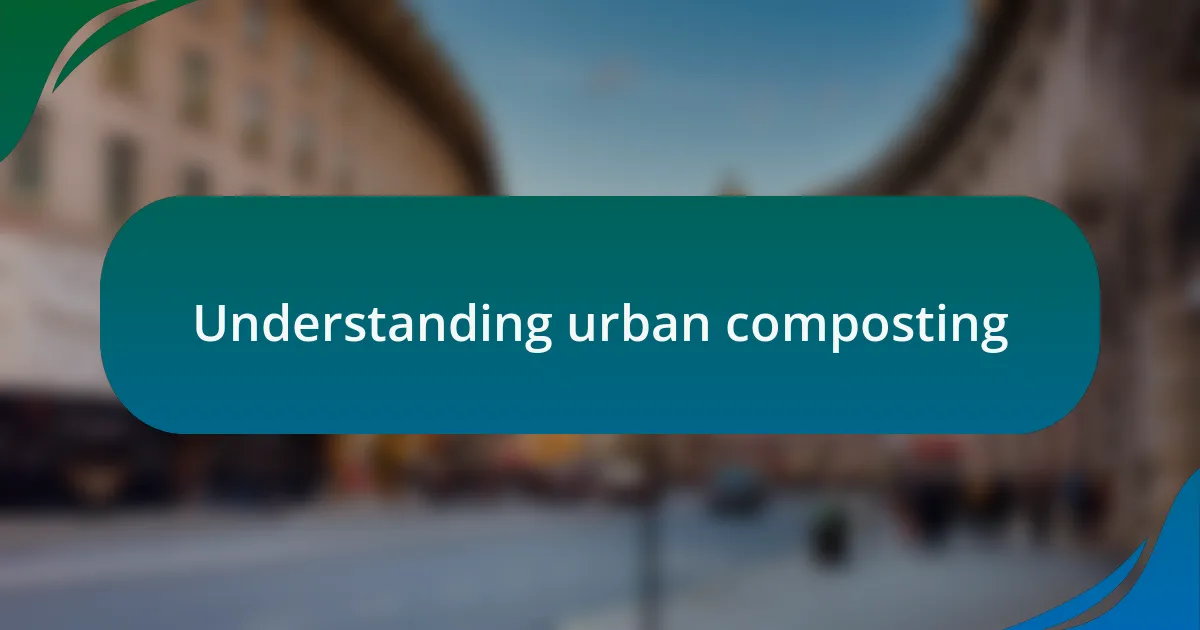
Understanding urban composting
Urban composting is essentially the practice of recycling organic waste in densely populated areas where space is often limited. I remember the first time I started composting in my small apartment—wondering if I could really make a difference with just my kitchen scraps. It felt like a personal challenge, but I realized that even small actions can contribute significantly to reducing landfill waste.
In a bustling city, the concept of composting can seem daunting. How can we effectively turn our vegetable peels and coffee grounds into nutrient-rich soil without much room? I found that using a compact compost bin made it possible, and it was rewarding to watch my waste transform over time. Seeing the dark, rich compost emerge reminded me that organic waste is a precious resource, not just clutter.
Understanding urban composting also involves recognizing the community aspect it fosters. When I joined a local composting group, I discovered the joy of sharing tips and even swapping compost with neighbors. This camaraderie not only educated me on best practices but also deepened my connection to my urban environment. Isn’t it fascinating how simple acts of composting can lead to a broader community impact?
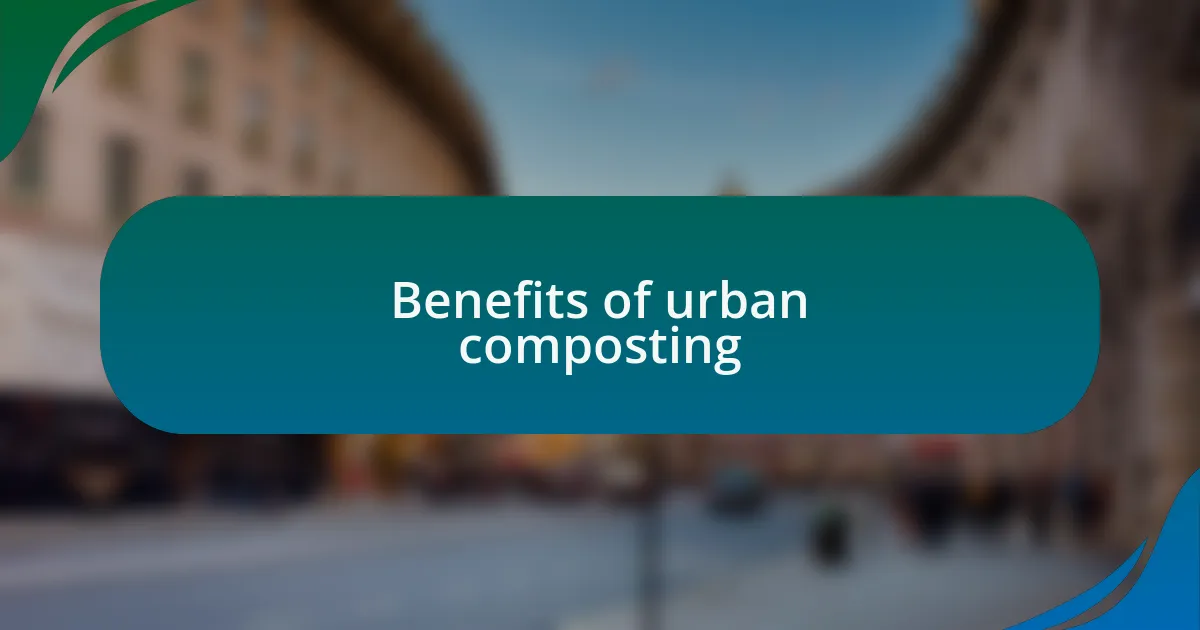
Benefits of urban composting
One of the most notable benefits of urban composting is its positive impact on the environment. When I started composting, I was amazed at how much waste I was diverting from landfills. It struck me that a simple act, like composting my vegetable scraps, could reduce greenhouse gas emissions significantly. Each time I tossed another banana peel into my bin, I felt a little surge of hope, knowing that I was contributing to a healthier planet.
Moreover, urban composting enriches city soil and supports local gardening efforts. I often share my compost with neighborhood gardeners, which makes me feel incredibly connected to my community. When I see the plants thriving with the nutrient-rich compost I helped create, it’s rewarding—like planting a little piece of my efforts back into the earth. Doesn’t it feel good to know you’re not just throwing things away but actively participating in a cycle of growth?
There’s also the educational aspect that can transform how we view waste. Through my composting journey, I’ve discovered there’s so much to learn about food scraps, worms, and the science behind decomposition. Each time I educate someone about composting, I feel a spark of excitement—I can see the shift in their mindset as they realize their potential impact. Isn’t it empowering to be part of a movement that not only conserves resources but also inspires others to think differently about waste?
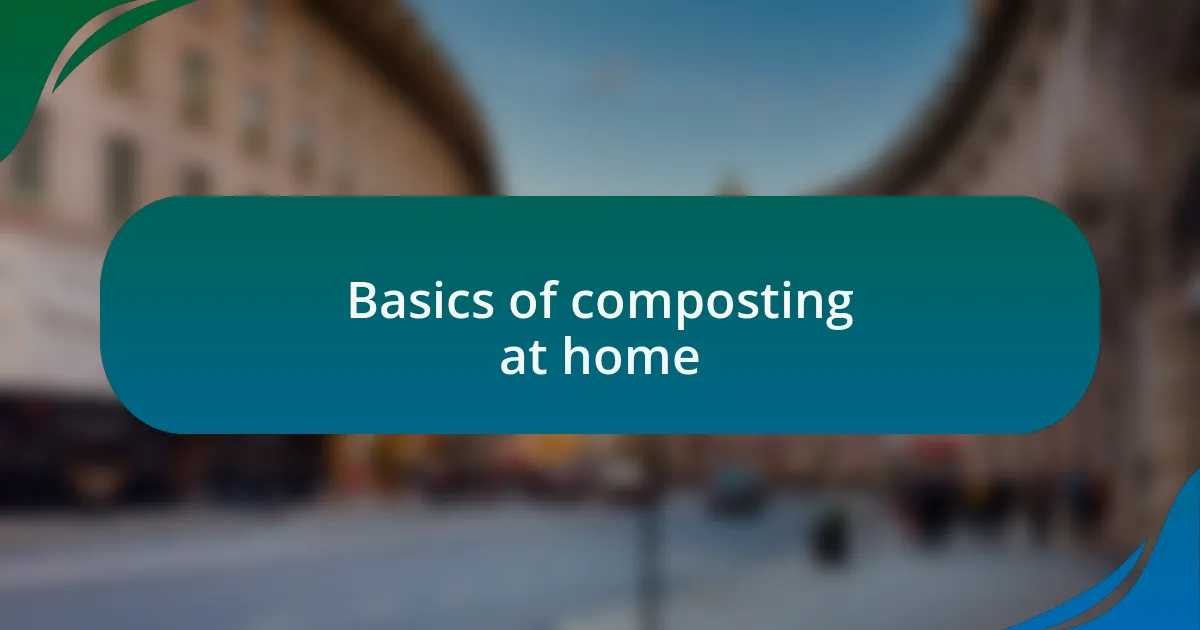
Basics of composting at home
When I first ventured into home composting, I quickly learned about the essential components needed to succeed. The balance of greens and browns—kitchen scraps like fruit peels and dry leaves or cardboard—was crucial. I remember the satisfaction of stirring my compost pile and smelling that earthy aroma, feeling deeply connected to nature, even in the heart of the city.
Setting up my compost bin was surprisingly simple. I chose a small, discreet tumbler that fit perfectly on my balcony. It was gratifying to toss in my vegetable scraps and watch the process unfold. Have you ever felt that rush of joy when you integrate something sustainable into your daily routine? For me, it was like bringing a piece of the outdoors inside.
As I ventured deeper into composting, I began to experiment with different materials. I never expected coffee grounds to become such a favorite addition—they’re an excellent source of nitrogen! Each time I discovered something new about composting, it felt like unlocking a mini mystery, fueling my enthusiasm even more. I still remember the first time I used my compost in my indoor plants and watched them flourish—what a rewarding moment!

Materials suitable for urban composting
When it comes to materials suitable for urban composting, I’ve found that the variety available can be quite surprising. For instance, I can’t overlook the impact of fruit and vegetable scraps. After a lively dinner, tossing in those onion skins and apple cores makes me feel like I’m giving new life to what would otherwise end up in the trash. Have you noticed how even the smallest contribution can feel significant?
I also discovered the importance of including dry materials. Things like shredded newspaper and cardboard are perfect for balancing out the moisture from food scraps. I remember my first time adding used pizza boxes; it felt a bit strange, but I soon realized they broke down beautifully. The satisfaction of reducing waste while enriching my compost was worth every second of uncertainty.
Lastly, let’s not forget eggshells. It’s remarkable how something so fragile can provide such a boost of calcium. I used to think of them as mere trash, but now they’re a staple in my compost pile. Have you ever experienced that shift in perspective? It’s incredible how urban composting opens your eyes to all the life hidden in our waste.
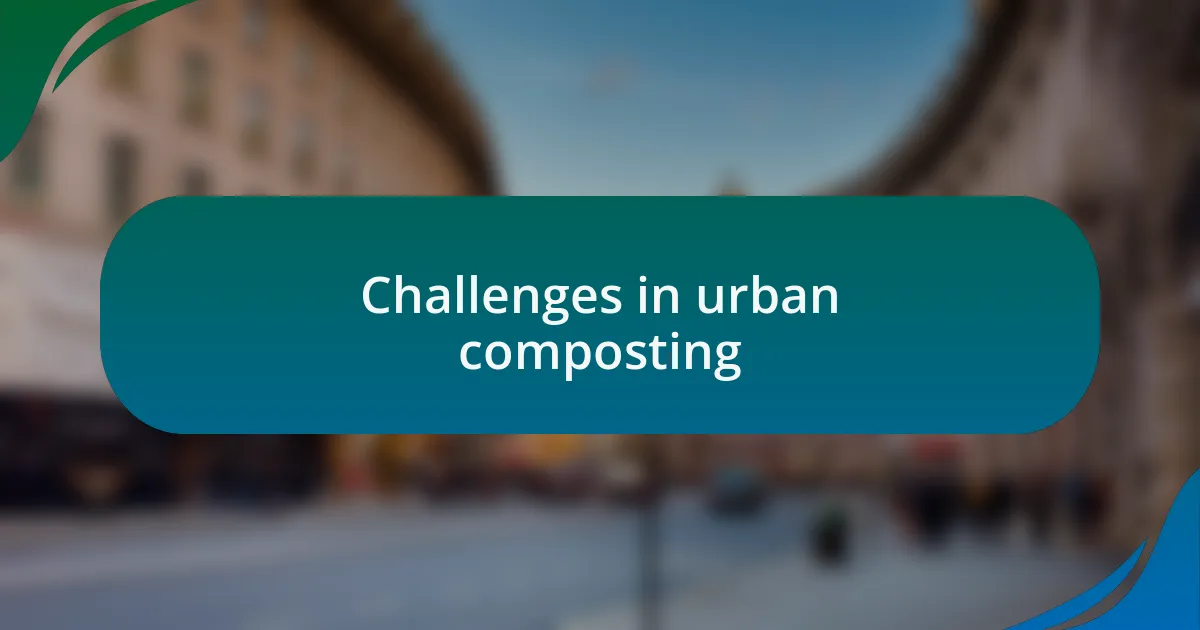
Challenges in urban composting
Urban composting isn’t without its hurdles. One of the most frustrating challenges I’ve faced is dealing with space limitations. Living in a small apartment means I can’t always have a traditional compost bin. Instead, I tried using a compact worm bin in my kitchen. Initially, I was skeptical about how manageable it would be, but surprisingly, it turned out to be less daunting than I anticipated. Have you ever had that moment when a solution just clicks?
Another significant issue I’ve encountered is the odor. I remember the first time I opened my compost bin and was hit by a rather unpleasant smell. It was more than a little off-putting! After doing my research, I learned that proper aeration and maintaining a good carbon-to-nitrogen ratio can help. Now, I’m much more aware of how I layer my materials, which has made a world of difference. Have you experienced any unpleasant surprises in your composting journey?
Pest control can be a real pain point too. Early on, I struggled with fruit flies infiltrating my compost setup every summer. It was disheartening to say the least. I discovered that tightly sealing my compost container and using traps helped keep them at bay. It’s funny how such a small problem can be so discouraging. Have you ever felt like giving up because of these tiny invaders? Remember, each challenge is a step towards becoming a better composter.
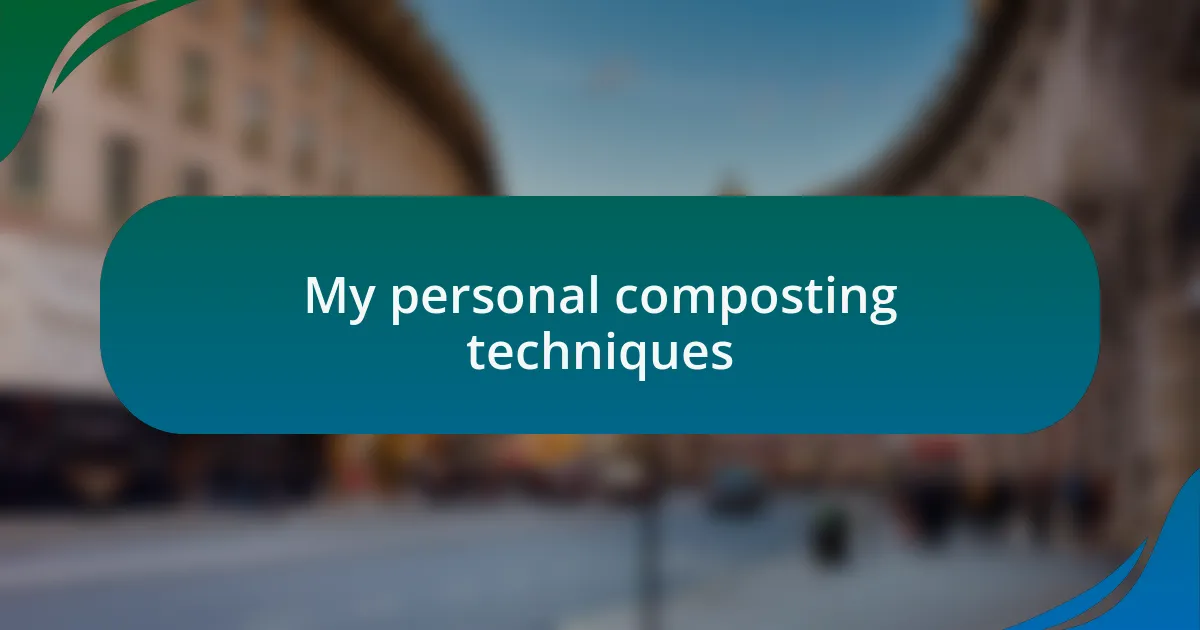
My personal composting techniques
One technique I swear by is creating a mini compost pile on my balcony. I use a simple approach: starting with a layer of dried leaves, followed by kitchen scraps, and topping it off with a layer of soil. It’s quite satisfying to watch the layers break down over time. Have you ever felt that moment of anticipation when you know you’re nurturing something? That’s how I feel when I check my pile every few weeks.
Container choice has made a significant difference for me too. I’ve adopted a three-bin system, where each bin serves a dedicated purpose—one for active composting, one for curing, and the last for materials waiting to break down. This organization has streamlined my process and minimized the mess. It’s like having a little rhythm to my composting dance. Ever found that a system makes even the messiest tasks feel more manageable?
Lastly, I try to engage my community by sharing composting tips and successes locally. I’ve found that when I discuss what’s working for me, it sparks inspiration in others. One neighbor even swapped her coffee grounds for some of my finished compost! That exchange was not only practical but also fulfilling. Have you discovered how sharing experiences can amplify your own composting journey? It truly transforms the process into a community affair.

Tips for successful urban composting
When diving into urban composting, understanding the right balance of materials is vital. In my experience, achieving that “green to brown” ratio—approximately one part green materials, like fruit scraps, to three parts brown materials, such as dried leaves—works wonders. Have you noticed how this balance can foster a faster breakdown? It’s almost as if the compost is whispering secrets about what it craves.
Airflow is another key component many overlook. During my early attempts, I learned that regularly turning the pile enhances oxygen circulation and speeds up the decomposition. It’s not just about mixing things up; it’s the little acts, like grabbing a pitchfork and giving your compost a stir, that make me feel connected to the process. Have you felt that spark of energy when you know you’re nurturing your compost? It’s invigorating!
Finally, patience is an urban composter’s best friend. There were times when I grew frustrated, waiting for the perfect dark, crumbly soil to emerge. But with each passing week, as I noticed subtle changes, I learned to appreciate the journey. Have you ever realized that good things take time? Embracing this patience transformed my approach, reminding me that nature has its own schedule.